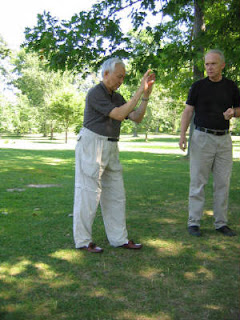Daily Classical Tai Chi Walking
Ordinary vs. Classical Tai Chi lower body movement
When discussing ordinary walking, we note extraneous head movement rather than what happens with Classical Tai Chi Walking. People’s heads naturally bob up and down when ordinary walking due to a pendulum-like mechanism. This movement helps to reduce energy expenditure by allowing the head to oscillate in sync with the body’s stride. Research suggests that humans bob their heads about 0.5-1.5 cm (0.2-0.6 inches) with each step, primarily during flat walking.
In addition to energy conservation, head bobbing might contribute to gaze stabilization. As the body moves forward, the head bobs up and down to momentarily fixate the eyes on objects ahead, ensuring a stable visual perception.
Comparison to Other Bipedal Animals
Humans seem to have the most vertical head movement! While humans exhibit head bobbing while walking, other bipedal animals, such as birds, do not. Birds have a different gait and visual system, which may not require the same level of head stabilization. In fact, birds’ heads tend to move more laterally, perpendicular to their direction of motion, rather than vertically like humans'.
Evolutionary Adaptation
The human head-bobbing mechanism is thought to be an evolutionary adaptation to our unique bipedalism. Our relatively straight legs and upright posture require adjustments in our visual system and head movement to maintain stability and efficiency while walking. This adaptation allows humans to conserve energy and maintain clear vision while navigating their environment.
In Conclusion
When ordinary walking, people’s heads naturally bob up and down due to a pendulum-like mechanism. This mechanism helps reduce energy expenditure and stabilize gaze. This unique adaptation is a hallmark of human bipedalism and distinguishes us from other animals.
Classical Tai Chi Movement Principles
According to Master Stephen Hwa, classical Tai Chi emphasizes internal discipline, where movements are initiated from the internal core of the body rather than from the external parts. This approach enables the cultivation and mobilization of internal energy for health benefits and martial arts applications.
Pulling vs. Pushing
Classical Tai Chi uses " pulling " instead of “pushing” the body. This means that the movement is driven by the contraction of the core rather than by the external muscles. This approach helps to maintain balance and stability and prevents the head from bobbing up and down.
Core Contraction and Movement
In classical Tai Chi, movement is initiated by the contraction of the core. For example, when taking a step, the abdomen and back lift the pelvis, which in turn lifts the leg. The foot is then moved forward, and the pelvis is stretched downward until the foot is fully planted. This movement is internally driven, with the upper body remaining still.
Benefits of Internal Movement
The use of internal movement in classical Tai Chi offers several benefits, including improved health and well-being and enhanced martial arts and sports performance. This approach is demanding to learn, but the results are unparalleled.












